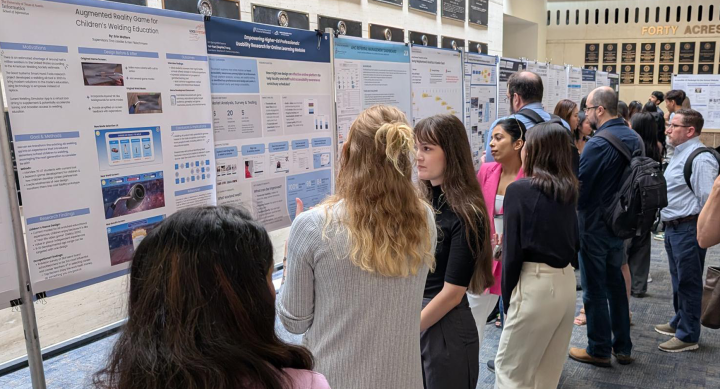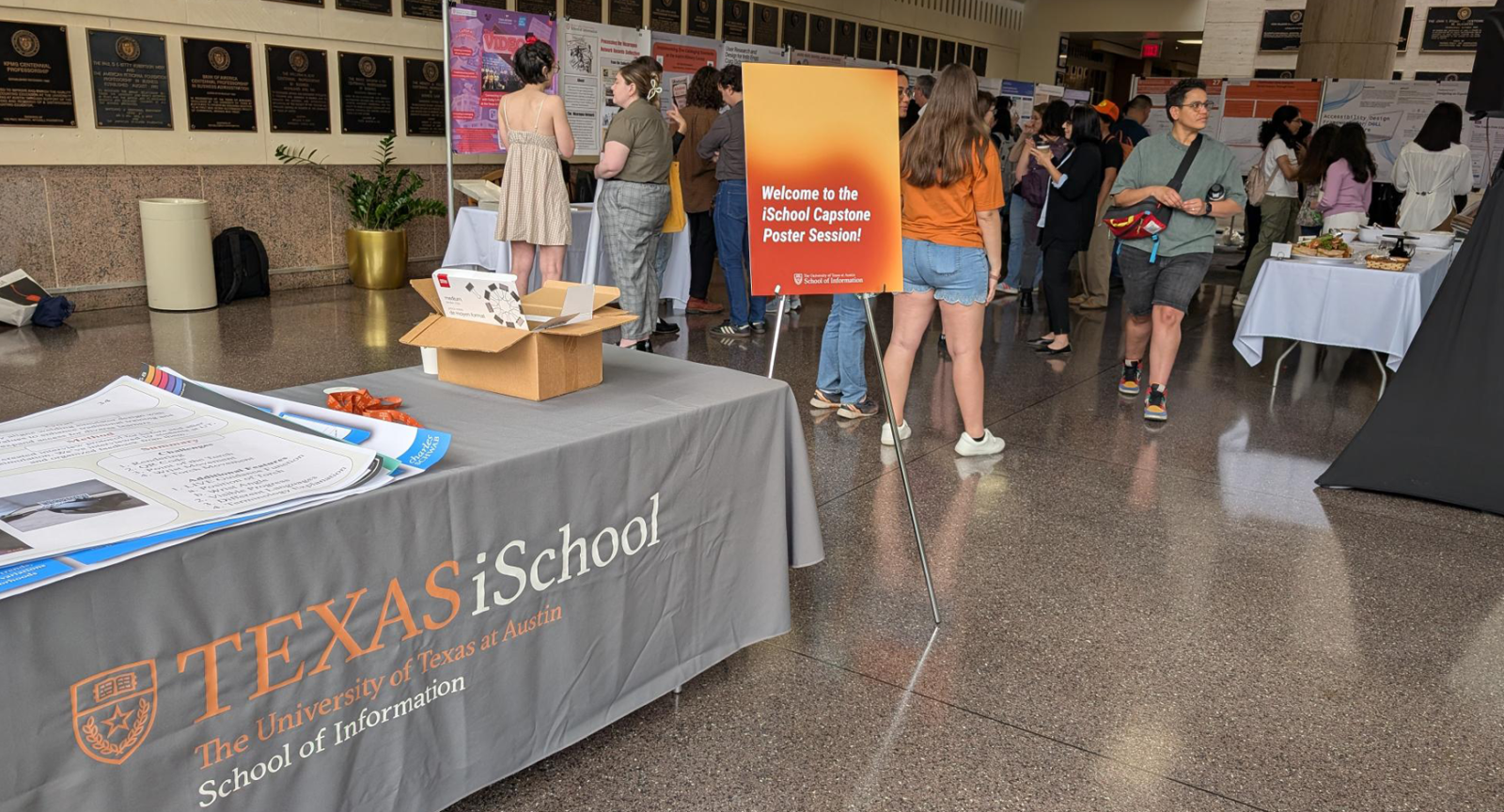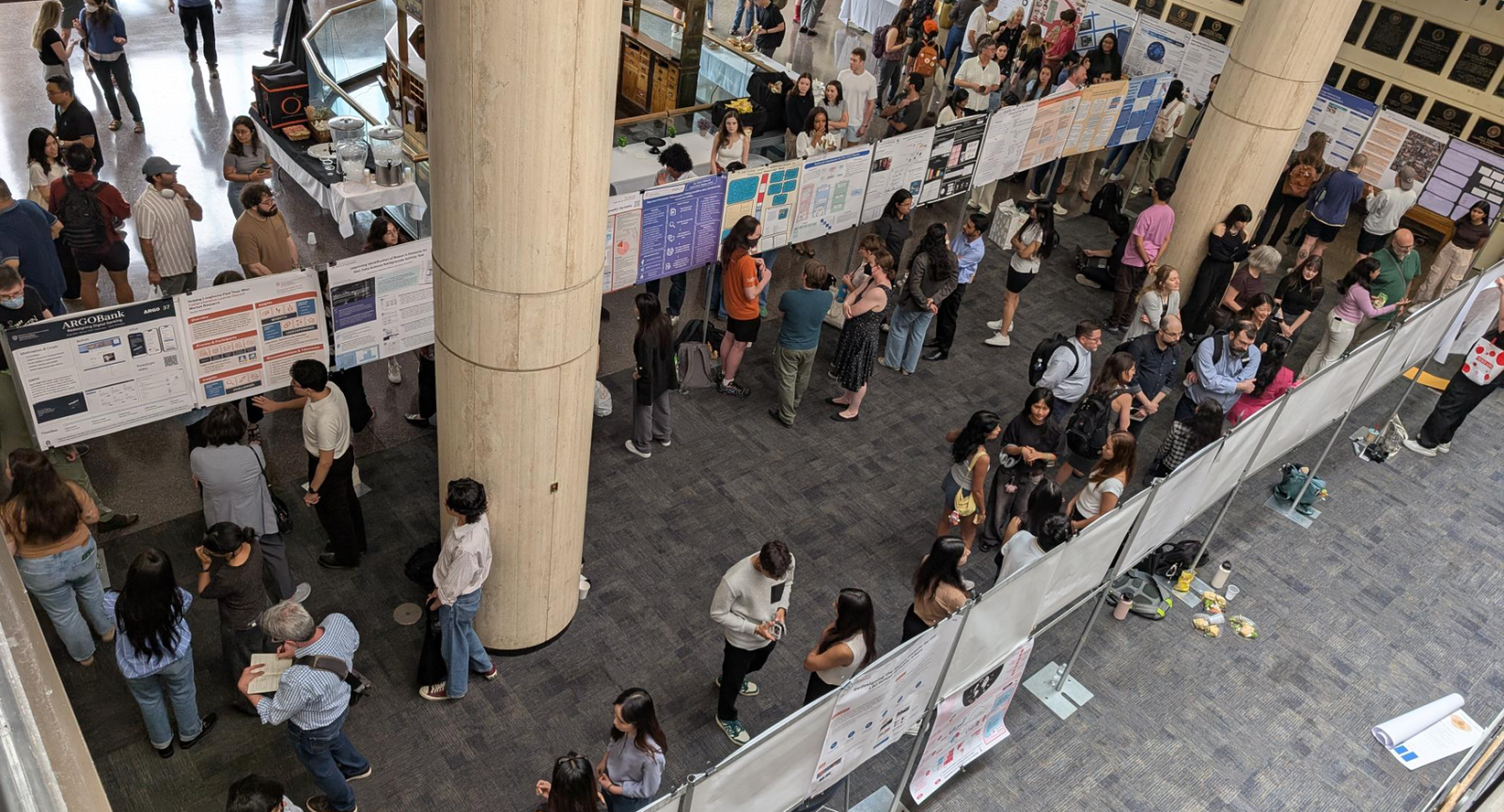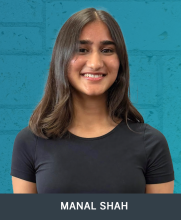
This year’s Capstone Poster Session, held April 28 at McCombs School of Business, was a tour de force of impressive projects, featuring over 150 presentations from undergraduate and graduate students alike. Posters presented ranged from master’s theses and library practica to professional experience projects and focused research reports.
During the event, iSchool faculty and administrators rubbed elbows with students to view and discuss projects in an informal, intellectually gregarious setting. Standing beside their posters, students led impromptu discussions of their projects and answered questions from both experts in the field and fellow students new to the subject matter.
Each year, the iSchool dean selects four posters for special recognition – two each from both the undergraduate and graduate cohorts. This year, among graduate students, Interim Dean Soo Young Rieh selected Manal Darpan Shah as winner and Anjana Menon as honorable mention. Both are completing the Information Studies MS program this spring. Among undergraduates, Rieh picked Abigail Stark as winner and Karina Gavin as honorable mention.
"As I reviewed many of the digital posters ahead of the Capstone Poster Session and spoke with numerous students presenting their projects with such passion and enthusiasm at the event, it became clear how impressive this year’s capstone projects are," Interim Dean Rieh said. "Choosing the best posters was not an easy task for me and the two associate deans because every project stood out in its own way. The entire review process reaffirmed my belief that the UT iSchool is educating leaders who will make an impact across a wide range of professional areas. Congratulations to the four award winners, and just as importantly, congratulations to every student who participated in this year’s Capstone Poster Session!"
Congratulations to the winners, and to all who shared their research!

| 
| 
|
Graduate Dean’s Choice Award Winner: Manal Shah

For the past year, while completing her MS at the iSchool, Shah has been working for Verveware, a Chicago-based company that offers user-friendly technology to home care providers. Shah’s winning Capstone project, titled “Empowering Care Through Seamless LMS Integration,” recaps her efforts to build better UX for Verveware’s caregiver training offerings.
Shah’s project aims to streamline training and compliance for homecare agencies, ensuring that administrators can easily track progress and that caregivers train on a single system for faster onboarding. She used Figma, a collaborative web application for interface design, to simplify complex workflows for both caregivers and administrators/supervisors. Her poster displays these roadmaps alongside mock-ups of what the user experience might look like on the screen. A next step will be to build dedicated training software.
Shah emerges with industry experience designing for learning management systems (LMS) – that is, software applications that oversee training and education. She credits the iSchool with giving her the tools to take on any UX challenge.
“The iSchool gave me the foundation I needed to transition from software engineering into UX design,” Shah says. “Through supportive faculty, hands-on courses and a collaborative environment, I built the skills and mindset to approach design with confidence. I got to apply everything I learned during my capstone at Verveware, where I led the design of a LMS from the ground up. Taking full ownership—from user research to final handoff—was a defining moment that showed me what it takes to create meaningful, real-world solutions. As they say, ‘What starts here, changes the world’—and I truly felt that.”
Shah adds: “The iSchool taught me the craft—Verveware let me own it.”
Graduate Dean’s Choice Award Honorable Mention: Anjana Menon

Like Shah’s, Menon’s Capstone was devised in an industry setting – in her case, at Splunk, a cybersecurity company recently acquired by Cisco. With a collaborator at Splunk, Anjana completed the project “Visualizing the Impact of the Splunk UI Design System in Large Product Teams.”
Splunk’s UI design system helps 30 different product teams collaborate. However, large teams at the company were finding it difficult to measure return on investment or prioritize resources due to poor understanding of the design system’s usage. Menon surveyed team members and stakeholders, identified gaps in visibility and built dashboards to track adoption across teams. This allowed her to note where more support was needed.
Views in Menon’s project are tailored to different user needs. Key visualizations she employs include an adoption funnel, which shows where teams are in the UI adoption journey, and category breakdown charts, which show how consistently system tokens are used across design categories.
"I saw that measuring a design system’s usage and adoption is essential, because its impact extends far beyond the design team; it shapes the experience of every product built with it,” Menon says. “By tracking how it’s used, we can ensure consistency, spot gaps and improve efficiency across the entire company. This showed me how data can turn a design system into a strategic asset that scales design quality and impact across all teams."
Undergraduate Dean’s Choice Award Winner: Abigail Stark
Stark worked with faculty supervisor Yan Zhang to complete her capstone project, “Review of Mental Health Applications & User Experience.” The project seeks to gain deeper understanding of popular mobile applications that claim to help manage mental health and well-being.
After preliminary research on commercially available mental health apps, Stark selected 11 leading apps for review. To assess the market, she completed a uniform audit of each app’s mechanisms and affordances and used Python to extract 660 user reviews from mobile app stores. She ran a qualitative analysis on these reviews using MaxQDA software and is in the process of compiling a final report.
Stark’s initial findings are that, across the board, the apps seem to generate too many similar-sounding affirmations, and that some affirmations can be “cheesy,” low-quality and even emotionally harmful. On the bright side, users often remarked that the apps cultivate a positive mindset, facilitate self-growth and inspire in moments of discouragement.
Stark’s findings open questions about quality versus quantity in mobile mental health applications. On her poster, she voices some skepticism that currently available apps offer real solutions for users struggling with mental health. “Are affirmations an effective long-term mental health fix?” she asks. “Or are they a band-aid solution to mental health?”
Undergraduate Dean’s Choice Award Honorable Mention: Karina Gavin
For her Capstone, “Finding Aid for the Octavia Magoffin Glasgow Collection,” Gavin worked with Prof. Jamie Ross and sponsoring organization the Texas Historical Commission. The project involved archival research, data organization, metadata creation and the use of digital tools for cataloging and creating finding aids.
Octavia Magoffin Glasgow (1900-1986) was a teacher, librarian and world traveler who lived at what is now the Magoffin Home State Historic Site in El Paso. Her father was a four-term mayor of the city who helped bring utilities and railroads to the region. Octavia traveled to East Asia several times as a young woman, studied art in Europe, and lived in the historic adobe homestead until her death. When the Texas Historical Commission took over the site in 2007, they found that very little archiving had been done for the many fascinating artifacts from Glasgow’s life and travels, from letters and photographs to postcards and original artwork.
Gavin’s documentation, cataloguing, and finding aid represent a major step towards making this treasure trove of early-twentieth-century cosmopolitan El Paso accessible to researchers. She began by building an inventory of the 126 folders of material, documenting elements such as date, subject and preservation needs, then drafted a finding aid with a brief biography, summary of the collection and suggested organization of the collection with subjects and descriptions of each series.
A complete reorganization and relabeling of folders using Gavin’s suggested organizational scheme remains to be done. “Once rearrangement is complete, researchers can easily access the materials for their studies, allowing for further growth in our understanding of the history of this unique multicultural family,” Gavin writes. “The Texas Historical Commission will also be able to utilize materials from the collection in future exhibits, showcasing Octavia’s artwork and telling the story of her fascinating and colorful life.”
Congratulations to all who shared projects at this wonderful event!

